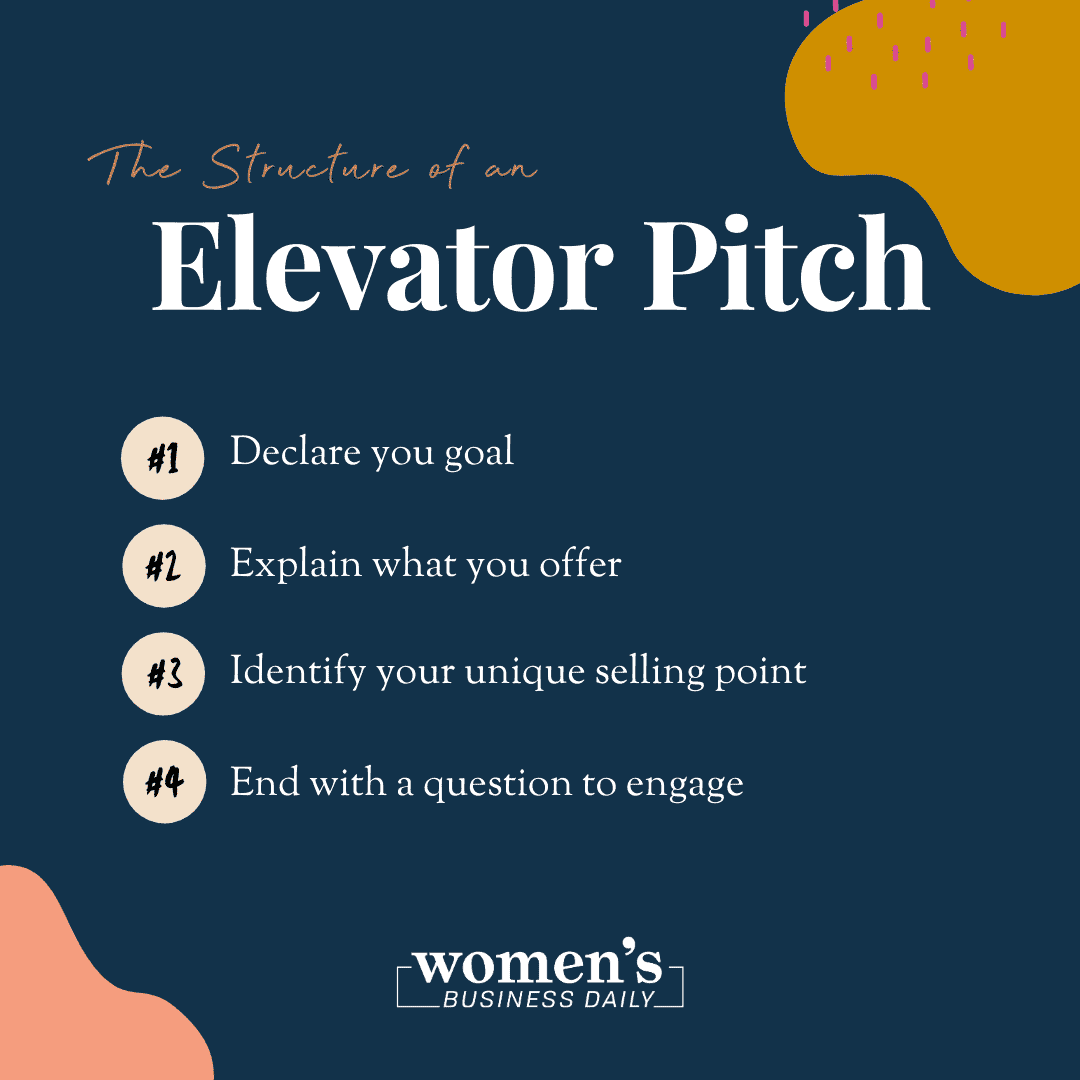Got the perfect idea for a company and you’re looking for investors? Want to explain to your boss that you deserve that promotion? Want to demonstrate to a corporate higher-up that you’re the perfect addition to their company? Then it’s time to perfect your elevator pitch!
No matter what you’re trying to sell – whether it’s a physical product, an idea for a company, yourself as an employee, or something you’d like to convince your boss to support – nailing the elevator pitch is the key to getting your foot in the door. It’s not the entire proposal, but a glimpse into the exciting proposition you have to offer.
So when you only have one chance to catch someone’s attention, how do you nail the pitch? Here’s a starter’s guide on how you can ensure that when the opportunity arises to make your pitch, you’ll be more than ready.
Where Does the Term Elevator Pitch Come From?
The term elevator pitch or elevator speech refers to the amount of time you have alone with the person you’re pitching to while you travel together in an elevator. Since you’re both in the same spot and there’s nowhere to go, you have a captive audience, but only for a few seconds, so you need to make your point convincingly and quickly.
Not all of these pitches happen in an elevator of course, but the concept refers to any pitch you have to make when the time is limited and you need to give your audience something memorable to think about when they walk away. You don’t have time to outline the nuts and bolts of your business plan, but you do have time to give them a taste of your idea that’s intriguing enough that they want to come back for more.
There are plenty of places other than the elevator that are perfect for this type of pitch:
- Networking Events: Job seekers and recruiters alike will both have their own version of a speech ready to go in the event that the job seeker finds a company they like or the recruiter finds someone that is the perfect fit for an open position in their company. Before you launch into your speech, make some small talk about who you are, your goals, your passions outside of work, and the event itself. You don’t want to launch into the pitch right after the initial handshake at an event like this. It’s more about mingling and making organic connections rather than transactional conversations.
- Business Meetings: Whether you’re pitching your idea to your own company or visiting a different company to make a sales pitch, you need to grab their attention with a quick rundown of your pitch before expanding into the more lengthy, important information. This short and sweet starter will help them decide what level of interest they should show in your proposal, so give them something to reel them in!
- Job Interviews: Interviews range widely in scope and length. Sometimes you have an hour-long interview, an hour of test programming, and a tour of the facility. Sometimes you only have fifteen minutes to make yourself memorable. In those moments when your amount of time is limited, deliver your elevator pitch not for products and services, but for yourself. When the interviewer asks you to tell them about yourself, use that thirty seconds to make yourself interesting, framing your unique selling points that would make you an asset to the company as opposed to other candidates. Just like all elevator pitches, make sure to set yourself up for success by preparing properly!
- Chance Encounters: Sometimes, if you’re lucky, an opportunity arises that you weren’t expecting: you meet the CEO of the company while you’re walking down the hallway, you get seated beside someone in a position of power during a luncheon, or you happen upon someone looking to invest while in a coffee shop. These moments are rare and exhilarating, so be prepared for when and if they occur!
The Structure of an Elevator Pitch
The standard elevator pitch should be no more than 20 to 30 seconds: the average elevator ride. Of course, this can be expanded to fit a more relaxed setting. But when time is of the essence, it’s essential that you get these main points covered in that short timespan:
- Declare your goal. Your first sentence should explain why you are about to make this pitch.
- Explain what you offer. Use this part of the pitch to further dive into what your idea accomplishes or offers.
- Identify your unique selling point. Explain what makes your particular idea special; what separates it from all the other ideas like it?
- End with a question to engage your audience. Your goal of the pitch is to continue the conversation. Give your audience the reigns in the conversation so they can direct it to the elements they are most interested in.
Based on those principles, here is an example pitch.
(1) I recently started a company called Ethical Cleaners. (2) A lot of cleaners on the market today use harsh chemicals that have a negative impact on the environment. We’re a cleaning company that promotes sustainability to protect the earth while getting our clients’ homes and offices clean. (3) My company employs kids aging out of the foster care system. When these kids turn 18, they no longer get housing or assistance, so we wanted to give them an opportunity to work at a livable wage and gain valuable employment experience. (4) When choosing a cleaning company, how important to you is sustainability?

Tips and Tricks to Perfect Your Elevator Pitch
Even if you have the content memorized and structured to a T, the success of the elevator pitch all comes down to the delivery. So what key elements of your delivery do you need to nail in order to ensure your success?
- Confidence: Confidence is key. The saying is so well-known because it’s true! Why should someone else believe in your idea if you don’t believe in it yourself? Once you sit down with the person for a future meeting to further explore the concept, you can be open to suggestions and ideas, but during the pitch, this is your time to project your unfailing devotion to your idea. Even if you’re shaking in your boots, you need to make your prospective client or investor think you unfailingly believe in your idea.
- Practice: Another well-known saying that holds true? Practice makes (almost) perfect. While you can never truly be perfect, you can make yourself as prepared as possible by practicing in front of a mirror or a friend. Ask your test subject how they felt the pitch went. What points did you not expand on enough? What fat can you trim from the content to tailor your pitch to something snappier? Does the pitch sound natural or conversational?
- Clarity and Speed: While you need to get your points across quickly, you need to also make sure that you aren’t speaking so quickly that your audience can’t understand you. Work on pacing so that you can get your points across in whatever amount of time you have without mumbling and stumbling over your words. Honing this skill makes the difference between an unsuccessful attempt and a good elevator pitch.
Now Go Nail That Pitch!
Whether you’re constructing an ad for social media, putting together your pitch with your sales teams, or trying to land your dream job, make sure you use whatever time you’ve got to make an impression. You don’t have to tell the whole story, but you do need to give your audience enough of a taste that they’ll come back begging for more information.
Do you have any tips from successful pitches you’ve given? Do you have suggestions based on a mistake you made in the past? Let’s hear about it in the comments!
Author, Artist, Photographer.
Sarah Margaret is an artist who expresses her love for feminism, equality, and justice through a variety of mediums: photography, filmmaking, poetry, illustration, song, acting, and of course, writing.
She owns Still Poetry Photography, a company that showcases her passion for capturing poetic moments in time. Instead of poetry in motion, she captures visual poetry in fractions of a second, making cherished keepsakes of unforgettable moments.
She is the artist behind the Still Poetry Etsy shop, which houses her illustrations and bespoke, handmade items. She is the author of intricacies are just cracks in the wall, a narrative poetry anthology that follows a young woman discovering herself as she emerges from an abusive relationship.
- Sarah Margaret Henryhttps://www.womensbusinessdaily.com/author/sarah-margaret-henry/
- Sarah Margaret Henryhttps://www.womensbusinessdaily.com/author/sarah-margaret-henry/
- Sarah Margaret Henryhttps://www.womensbusinessdaily.com/author/sarah-margaret-henry/
- Sarah Margaret Henryhttps://www.womensbusinessdaily.com/author/sarah-margaret-henry/





